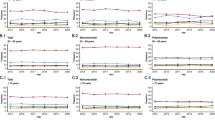Abstract
To determine the incidence and risk factors related to isolation of Pseudomonas aeruginosa or Enterococcus spp from urine cultures obtained from patients in the emergency department (ED), a 1-year prospective study was conducted of all urine specimens collected in the ED of a general hospital. Specimens from which one of these organisms was isolated at a concentration of ≥105 cfu/ml were included. Of 744 positive urine cultures, 39 (5%) were P. aeruginosa and 28 (4%) Enterococcus spp. Comparison with a control cohort of 80 patients with Escherichia coli bacteriuria revealed several univariate indicators for P. aeruginosa bacteriuria, including male sex, indwelling catheter, past prostatectomy, hospitalization in the previous 2 months and pregnancy; multivariate indicators were indwelling catheter (p<0.001) and male sex (p<0.001). Enterococcus and P. aeruginosa were significantly more often associated with asymptomatic bacteriuria. These data will help clinicians select appropriate antibiotic treatment for patients with urinary tract infections.
Similar content being viewed by others
References
Stamm WE (2002) Scientific and clinical challenges in the management of urinary tract infections. Am J Med 113(Suppl 1A):1–4
Raveh D, Rudensky B, Huerta M, Aviv Y, Yinnon AM (2003) An improved, evidence-based method for empirical treatment of urinary tract infection. Eur J Clin Microbiol Infect Dis 22:158–164
Gilbert DN (2005) Aminoglycosides. In: Mandell GL, Bennett JE, Dolin R (eds) Principles and practice of infectious diseases. 6th edn. Churchill Livingstone, Philadelphia pp 328–356
Roberts JA (1999) Management of pyelonephritis and upper urinary tract infections. Urol Clin North Am 26:753–763
Clarridge JE, Johnson JR, Pezzlo MT (1998) Cumitech 2B, Laboratory diagnosis of urinary tract infections. Coordinating ed. Weissfeld AS. American Society for Microbiology, Washington, District of Columbia
Rosenberg M, Berger SA, Barki M, Goldberg S, Fink A, Miskin A (1992) Initial testing of a novel urine culture device. J Clin Microbiol 30:2686–2691
Raz R, Okev N, Kennes Y, Gilboa A, Lavi I, Bisharat N (2000) Demographic characteristics of patients with community-acquired bacteriuria and susceptibility of urinary pathogens to antimicrobials in northern Israel. Isr Med Assoc J 2:426–429
Barrett SP, Savage MA, Rebec MP, Guyot A, Andrews N, Shrimpton SB (1999) Antibiotic sensitivity of bacteria associated with community-acquired urinary tract infection in Britain. J Antimicrob Chemother 44:359–365
Bishara J, Leibovici L, Huminer D, Drucker M, Samra Z, Konigsberger H, Pitlik S (1997) Five year prospective study of bacteraemic urinary tract infection in a single institution. Eur J Clin Microbiol Infect Dis 16:563–567
Weber G, Riesenberg K, Schlaeffer F, Peled N, Borer A, Yagupsky P (1997) Changing trends in frequency and antimicrobial resistance of urinary pathogens in outpatient clinics and a hospital in Southern Israel. Eur J Clin Microbiol Infect Dis 16:834–838
Huang YC, Lin TY, Wang CH (2002) Community-acquired Pseudomonas aeruginosa sepsis in previously healthy infants and children: analysis of forty-three episodes. Pediatr Infect Dis J 21:1049–1052
Pier GB, Ramphal R (2005) Pseudomonas aeruginosa. In: Mandell GL, Bennet JE, Dolin R (eds) Principles and practice of infectious diseases. 6th edn. Churchill Livingstone, Philadelphia pp 2587–2615
Lloyd S, Zervos M, Mahayni R, Lundstrom T (1998) Risk factors for enterococcal urinary tract infection and colonization in a rehabilitation facility. Am J Infect Control 26:35–39
Raveh D, Rudensky D, Schlesinger Y, Attias D, Yinnon AM (2003) Trends in bacteremias: analysis of 7544 patient-specific bacteremic episodes spanning 11 years (1990–2000). J Hosp Infect 55:196–203
Raveh D, Koppitt R, Hite Y, Rudensky B, Sonnenblick M, Yinnon AM (2002) Risk factors for nephrotoxicity in elderly patients receiving once-daily aminoglycosides. Quart J Med 95:291–297
Author information
Authors and Affiliations
Corresponding author
Rights and permissions
About this article
Cite this article
Raveh, D., Rosenzweig, I., Rudensky, B. et al. Risk factors for bacteriuria due to Pseudomonas aeruginosa or Enterococcus spp in patients hospitalized via the emergency department. Eur J Clin Microbiol Infect Dis 25, 331–334 (2006). https://doi.org/10.1007/s10096-006-0140-0
Published:
Issue Date:
DOI: https://doi.org/10.1007/s10096-006-0140-0




